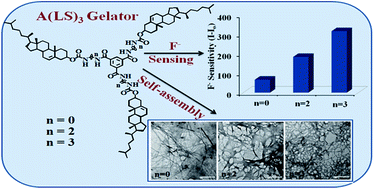New triangular steroid-based A(LS)3 type gelators for selective fluoride sensing application†
Abstract
A new series of cholesteryl based triangular A(LS)3 type molecules, compounds 1–4, has been synthesized and tested for gelation and anion sensing applications. Melamine or benzene-1,3,5-tricarbonyl chloride (BTC) was used as an aromatic platform precursor (A) in these compounds around which three cholesteryl derivatives (S) were arranged using linker units (L). In compounds 1–4, the molecular structures were systematically altered by changing the aromatic platform, the chain lengths of the linker units as well as by introducing additional hydrogen bonding functionalities onto the linker units. It was found that the gelling as well as self-assembly properties of the compounds 1–4 can be controlled by systematically changing their structural components. STEM and TEM analyses on xerogels of 2–4 from triethylamine solvent revealed that the fundamental units of these xerogel networks are fibres which get assembled into more porous fibrous networks as a function of the chain length of the linker units. Moreover, these compounds were capable of sensing the hazardous F− ions selectively out of the 11 anions tested by exhibiting fluorescence enhancement. The F− sensing ability of these compounds could be controlled by changing the length of the linker unit. In some cases, visual changes such as change in color of the gel or gel to sol transformation were also observed on addition of F− ions. A possible mechanism for the observed sensing of F− ions is also proposed in this study.


 Please wait while we load your content...
Please wait while we load your content...